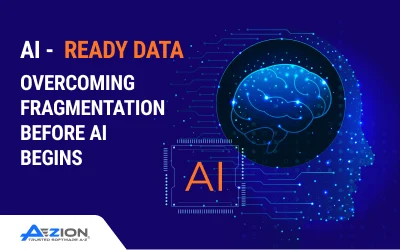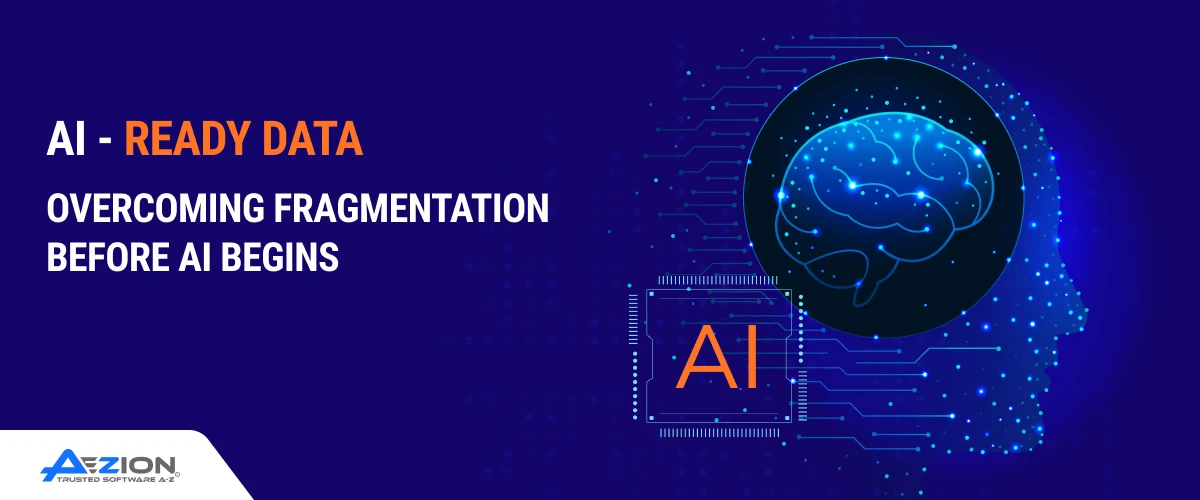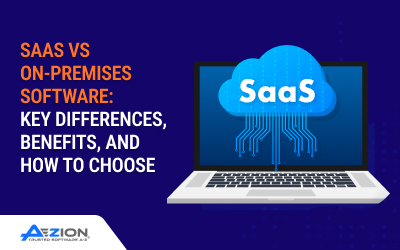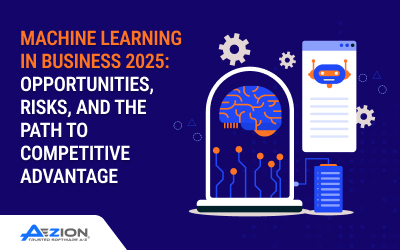Summary
Organizations rushing into AI initiatives often overlook one critical requirement: AI-Ready Data. Fragmented systems, legacy infrastructure, and unstructured datasets make it challenging to support machine learning, automation, and intelligent decision-making processes.
This blog explores the challenges of fragmented data environments and outlines how to establish a clean, connected, and well-governed foundation that supports the accurate and scalable deployment of AI.
Introduction to AI Ready Data
Most organizations aim to leverage AI to enhance decision-making, eliminate inefficiencies, or accelerate innovation. However, before any of this becomes possible, foundational AI-ready data must be in place.
Poor data structure, quality issues, and disconnected systems often slow or even break AI initiatives. Actual Data Readiness for AI means solving these foundational issues before any model is trained or deployed. Without that, AI becomes an expensive and underperforming investment.
What is AI Ready Data?
Challenges of Fragmented Data
Many AI projects fail before they begin due to a broken data foundation. Fragmentation across systems, tools, and workflows weakens consistency, access, and usability. To build reliable AI ready data, organizations must first confront these core obstacles that impede integration, coordination, and flow.
1. Disconnected Systems and Conflicting Formats
Departments often manage data in isolated tools with incompatible structures. This results in disjointed inputs that lack cohesion, making it difficult to prepare data pipelines for model training or inference across teams and applications.
2. Outdated Infrastructure and Manual Processes
Legacy systems and non-digitized workflows slow access to current data and limit scalability. These systems lack flexibility, making it harder to collect, update, and convert inputs into machine-readable formats for AI pipelines.
3. Unstructured Data with No Context or Classification
Text, audio, images, and logs often remain untagged or unlabeled. Without a clear context, these unstructured assets stay disconnected from core systems and are difficult to transform into valuable AI training and inference datasets.
4. Inconsistent Data Quality Across Sources
Data collected from multiple channels often varies in accuracy, completeness, and format. Without consistent quality checks, AI models can consume unreliable data, resulting in flawed results, biased predictions, or costly retraining cycles.
Why Data Modernization Is the First Step Toward AI?
Effective AI systems depend on a well-orchestrated data layer that supports consistent ingestion, transformation, and feature extraction. Without modernized infrastructure, data pipelines become brittle, fragmented, and non-performant.
A strong foundation of AI-ready data requires not only integration but also the reengineering of data structures, sources, and access mechanisms.
Modernization involves decoupling monolithic systems, migrating to scalable platforms, and implementing frameworks for schema standardization, lineage visibility, and automated quality validation.
This transforms fragmented data lakes and silos into AI Ready Data architectures that support advanced analytics, model training, and continuous learning pipelines at scale.
Core Pillars to Make Your Data AI-Ready
Achieving data readiness for AI requires a framework that addresses both infrastructure and data lifecycle needs. These core pillars guide organizations in making data reliable, connected, and suitable for AI workloads across discovery, quality, governance, and labeling.
Data Discovery & Audit
Begin by identifying all data sources, including both structured and unstructured data. Document flows, access patterns, and risks of duplication. Auditing helps expose silos, outdated sources, and security vulnerabilities that need to be resolved before AI systems consume this data.
Data Integration & Engineering
Develop automated pipelines to ingest, transform, and align data from multiple sources. This includes batch and real-time flows, schema mapping, and format standardization. Integration creates a unified layer that supports analytical workloads and reduces inconsistency across systems.
Data Governance & Quality Management
Implement rules, validations, and lineage to manage trust and accuracy. Governance includes access control, compliance tracking, and anomaly detection. Quality checks are crucial for rejecting incomplete or corrupted entries that could degrade model performance or introduce bias.
Metadata Management & Lineage Tracking
Maintain technical, business, and operational metadata for each data asset. Lineage helps trace the source, transformations, and usage of data across applications. This improves auditability, trust, and reusability for future AI initiatives or training workflows.
Labeling, Annotation & Training Readiness
Supervised AI models need high-quality labeled data. Create annotation workflows to tag unstructured inputs, such as images, documents, or logs. Define taxonomies, labeling rules, and validation cycles to prepare datasets for training, evaluation, and version control.
Real-World Use Cases: AI Failure Due to Unprepared Data
Even global enterprises have experienced AI failure due to fragmented, unvalidated, or poorly labeled data. These cases demonstrate that without a solid foundation of AI-ready data, no algorithm or model can perform as intended—no matter how advanced the technology.
| Use Cases | Problem | Key Data Issue | Lesson Learned |
| IBM Watson for Oncology | AI failed to provide accurate cancer treatment recommendations | Trained on narrow, localized datasets | Without diverse, standardized data, AI models risk poor generalization |
| Amazon AI Recruiting Tool | Showed bias against women in hiring recommendations | Historical data was male-dominated and unvalidated | Biased or unbalanced training data leads to a discriminatory outcome |
| AI Tools for COVID-19 | Inaccurate predictions in clinical diagnosis tools | Poorly labeled, inconsistent medical imaging data | Urgent AI deployment without clean, tagged data undermines reliability |
| FBI Virtual Case File | The entire digital transformation project failed | Legacy system conflict, data silos, and poor integration | Ignoring data validation and integration stalls modernization before AI starts |
IBM Watson for Oncology
A case study on Henrico Dolfing mentions how IBM pitched Watson as a clinical AI that could assist oncologists with treatment recommendations. However, the system was trained using limited datasets from a single hospital. It lacked the diversity and governance required for broad deployment, demonstrating that AI without standardized, well-curated data introduces risk, rather than intelligence.
Amazon AI Recruiting Tool
Amazon’s internal AI for hiring was trained on ten years of historical resumes, mostly from male applicants. The system began downgrading resumes with terms related to women. This occurred due to unbalanced training data and the absence of a quality control pipeline, exposing the cost of poor AI Data Readiness in biased model behavior, according to an article on Reuters.
AI Tools for COVID-19 Diagnosis
A research report from the BMJ states that multiple AI systems developed during the COVID-19 pandemic were found to be unreliable. The UK’s Turing Institute found they were trained on inconsistent, untagged medical images lacking clinical context. The absence of properly labeled, standardized data meant predictions were inaccurate and unusable—highlighting why AI-ready data must precede urgent model development.
FBI’s Virtual Case File (VCF) Project
According to Wikipedia, the FBI has invested millions in modernizing case data through the VCF system. But poorly integrated legacy systems, conflicting formats, and undocumented flows led to project failure. This case reinforces the danger of pursuing transformation without auditing, consolidating, and validating data sources first—core steps of building an AI Ready Data Environment .
Industry-Specific Struggles for AI-Ready Data
Data fragmentation affects every industry differently. While the ultimate goal is to build AI-ready data, the obstacles vary based on regulations, system maturity, data volume, and workflow complexity. The following are key sector-specific challenges that hinder AI adoption and readiness.
Healthcare
Healthcare systems generate complex, multi-format data from payer systems, EHRs, labs, devices, and handwritten notes. But transforming this data into AI-ready formats is slowed by several systemic challenges that hinder standardization, labeling, and access control:
- Inconsistent formats across systems
- Lack of interoperability between providers
- Privacy concerns restricting data availability
- Sparse labeling for clinical AI training
These factors collectively limit the effectiveness of diagnostic and predictive care models.
Finance
Financial institutions rely on high-frequency, regulated data from diverse systems. Yet, legacy infrastructure and fragmented data environments complicate integration, especially when preparing data for AI-driven risk analysis, fraud detection, and compliance. The key obstacles include:
- Siloed customer and transactional records
- Outdated databases with missing fields
- Regulatory discrepancies between markets
- Limited transparency in historical data
These issues make it challenging to align and reconcile data across jurisdictions, increasing the time and complexity involved in building AI-ready pipelines.
Manufacturing
Sensor data from machines, production logs, and ERP systems are often unstructured or loosely connected. To train AI for predictive maintenance or defect detection, manufacturers must overcome several practical data challenges:
- No uniform tagging of IoT outputs
- Data stored in isolated machine systems
- Lack of context in production line logs
- Gaps in temporal alignment for sensor data
Without structured annotation and AI-ready pipelines, these gaps reduce model reliability and limit actionable insights on the factory floor.
Retail
Retailers collect data from POS systems, apps, inventory platforms, and CRM tools—but this data is rarely aligned. Gaps in structure and synchronization create significant hurdles for building unified customer profiles. Common data issues include:
- Fragmented purchase histories
- Different naming conventions across tools
- Inconsistent SKU-level metadata
- Data lags between stores and online platforms
To support personalization and forecasting, these systems must be harmonized to create AI-ready datasets across all retail channels.
Construction
Construction projects generate unstructured data from CAD files, site images, time logs, and daily reports. But turning this data into usable AI input is difficult due to fragmentation and a lack of standardization. Key data challenges include:
- No standard metadata for files and images
- Data scattered across contractors and tools
- Difficulty tagging events by time or location
- Minimal historical training data for risk models
An AI-ready data center must address these issues to support accurate project tracking, cost forecasting, and safety analysis.
AI-Data Readiness Roadmap
Preparing for AI begins long before any model is selected. This roadmap outlines the technical steps necessary to convert fragmented data into consistent and reliable pipelines. It provides a practical guide for building and maintaining AI-ready data across enterprise environments.
Audit Data Sources
Conduct a complete discovery and inventory of all internal and external data sources. Identify redundancy, data ownership, sensitivity levels, and gaps in access. This audit sets the baseline for architecture planning and consolidation.
Pro Tip: Involve both business and technical teams during this audit. Gaps often exist between what’s collected and what’s usable for AI.
Consolidate & Clean
Merge duplicate records, normalize formats, and remove incomplete or outdated entries. Clean data reduces model noise and minimizes bias during training. This phase is essential to ensure AI Data Readiness before integration begins.
Best Practice: Utilize metadata tagging and lineage tracking to streamline governance as your data grows and evolves.
Standardize & Integrate
Create schemas, naming conventions, and validation rules. Then build data pipelines to ingest and align inputs from CRMs, ERPs, APIs, and IoT systems. Standardization ensures a consistent structure across systems for downstream AI tasks.
Pro Tip: Build modular pipelines to allow flexible integration and upgrades without disrupting downstream systems.
Define Governance
Implement access controls, usage policies, and quality thresholds to ensure effective management. Governance frameworks allow teams to manage compliance, versioning, and trust. Without this, even clean data becomes risky for deployment at scale.
Best Practice: Embed governance into your platform with automation—not as a post-processing step.
Enrich & Label
Tag raw and unstructured data with relevant business context or machine learning labels. This includes annotation of text, audio, video, or sensor feeds. Labeled datasets are critical for model training, particularly for supervised learning approaches.
Pro Tip: Use domain-specific taxonomies and human-in-the-loop systems for high-value annotations.
Validate & Monitor
Deploy automated checks to detect drift, data decay, or pipeline failures. Continuous monitoring ensures the data stays valid as systems evolve. It helps maintain long-term performance for AI models in production environments.
Best Practice: Implement data observability dashboards to detect anomalies in real time.
Conclusion
Building AI models without preparing the underlying data often results in stalled projects and suboptimal outcomes. The reliability, relevance, and structure of data determine whether AI delivers value or creates noise. Organizations that focus on creating AI-ready data gain the clarity needed to train, evaluate, and maintain high-performing models.
Developing an AI-ready data center solution brings structure to fragmented systems, enabling long-term AI sustainability. It is not just a technical upgrade but a strategic requirement. Aligning architecture, governance, and labeling with business needs transforms AI from an experiment into a scalable, outcome-driven capability.
Ready to modernize your data for AI?
Talk to our solution experts at Aezion or Take a Data Readiness Assessment to get started.
FAQs
What does it mean to have data ready for AI?
It means the data is clean, structured, labeled, and accessible. It must also be consistent across sources and traceable from origin to application for AI models to function effectively.
Why do AI projects fail due to poor data?
Many AI initiatives fail because the data used is fragmented, outdated, or unlabeled. Without clear context and validation, models misinterpret patterns and produce unreliable or biased results.
Is structured data enough for AI models?
Structured data helps, but it’s often not sufficient. Unstructured formats, such as text, images, and sensor outputs, must also be processed, labeled, and standardized for a model to learn from them accurately.
What tools support data readiness for AI?
Standard tools include data cataloging platforms, pipeline orchestration tools, metadata management systems, and annotation software. These tools help teams prepare, label, and monitor data pipelines for consistent AI use.
How long does it take to make data AI-ready?
The timeline varies depending on system complexity, volume, and current data quality. For many enterprises, foundational readiness can take several weeks to months, depending on the scope of transformation.




